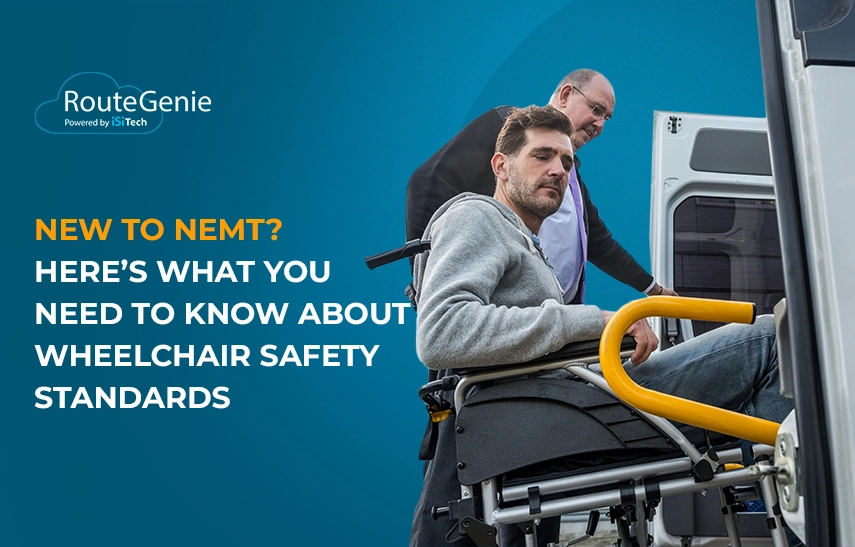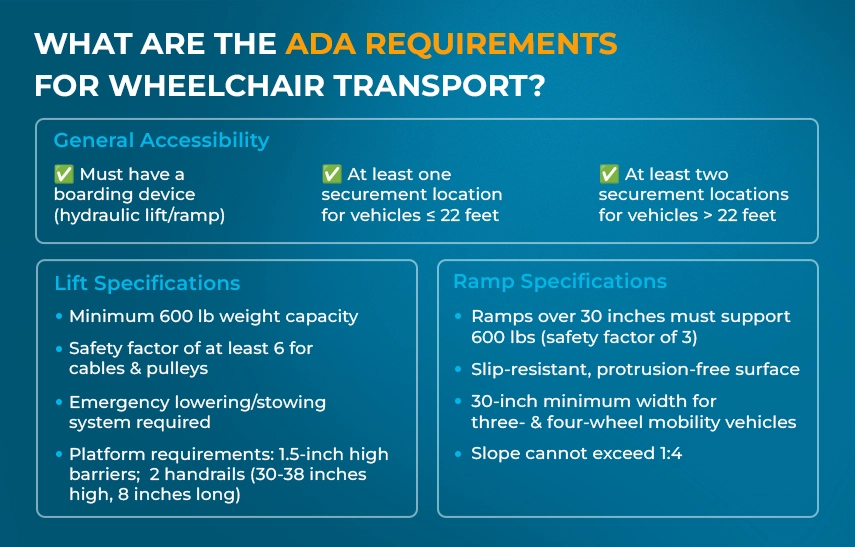New to NEMT? Here’s What You Need to Know About Wheelchair Safety Standards

Recent estimates suggest that well over 5 million Americans use wheelchairs. This is a significant figure and one that emphasizes the need for more accessible public transit, passenger vehicles, and particularly, non-emergency medical transport (NEMT).
Given that the main goal of your NEMT services is to ensure passengers with chronic conditions or disabilities get access to healthcare, maintaining wheelchair safety standards is key. What does this entail? Here’s what you need to know.
Contents:
- Understanding the Americans with Disabilities Act (ADA)
- What Are the ADA Requirements for Wheelchair Transport?
- Wheelchair Securement Systems and Specifications
- Maintenance Standards For NEMT Vehicles
- Driver Training Certifications
- Conclusion
Understanding the Americans with Disabilities Act (ADA)
When it was first signed into law in 1990, the Americans with Disabilities Act (ADA) outlined certain wheelchair transportation regulations for public transport providers.
Over the years, these guidelines have been adopted as the standard, even as the Act evolved to be more inclusive. Today, NEMT vehicles are expected to comply with the regulations outlined in the Act, which has a huge bearing on fleet management.
What Are the ADA Requirements for Wheelchair Transport?
 On the federal level, the ADA applies to three groups: public transport operators, private entities who provide public transit, and entities that operate on fixed routes, such as buses. However, recently, many states have brought private NEMT vehicles under the ADA’s ambit, too.
On the federal level, the ADA applies to three groups: public transport operators, private entities who provide public transit, and entities that operate on fixed routes, such as buses. However, recently, many states have brought private NEMT vehicles under the ADA’s ambit, too.
Even though the exact requirements vary from state to state, here are some wheelchair ADA requirements you should know about.
General Accessibility
All ADA-approved vehicles must be equipped with a boarding device—such as a hydraulic lift or a ramp—as well as at least one securement location.
For vehicles longer than 22 feet, the figures double, as each needs two securement locations and two boarding devices.
Lift Specifications
Vehicles equipped with a lift are expected to follow several rules. For one, the lift must be capable of carrying a load of at least 600 pounds. Moreover, crucial mechanisms used in the device—such as cables or pulleys—must have a safety factor of at least six.
But that’s not all:
- The vehicle must be equipped with a system to ensure the car doesn’t move when the lift isn’t completely stowed.
- The vehicle must have an emergency method to lower the lift or stow it, in the case of a power failure.
- The platform must have barriers that are at least 1.5 inches high.
- The platform must have at least two handrails that are between 30-38 inches high and at least 8 inches long.
Moreover, the ADA regulations outline specifics on how fast the platform should move, the gap between the vehicle and the platform, as well as the boarding direction.
Ramp Specifications
Similarly, ramps must meet certain criteria for a vehicle to be considered ADA-approved. These include:
- Ramps over 30 inches long must support a load of at least 600 pounds, and have a safety factor of at least 3.
- The surface must be slip-resistant and protrusion-free.
- The ramps must have at least 30 inches of clear width and be capable of accommodating both three- and four-wheel mobility vehicles.
- The slope of the ramp cannot exceed 1:4 when deployed at the ground level, but this figure is more flexible depending on the specific design.
- The ramp must be able to be properly stowed to avoid hurting or obstructing the passenger when in transit.
Meanwhile, some regulations apply for both. For example, the edges of lifts and ramps are required to be marked in contrasting colors. Additionally, the height of the vehicle’s door must be at least 56 inches from the top of the ramp or the raised lift platform.
Granted, there are a lot of rules to follow, which may get overwhelming without years of experience and expertise. So if you’re still struggling, check out this comprehensive guide to finding the perfect NEMT vehicle instead.
Wheelchair Securement Systems and Specifications
Along with strict ramp and lift regulations, the ADA also mandates that all vehicles under its ambit have at least one secured area. This ensures that the wheelchair-bound passenger always stays locked in when in transit.
Here are some wheelchair securement requirements to look out for:
- Straps or clamps capable of withstanding a force of at least 2,000 pounds, and a total force of no less than 4,000 pounds for the entire wheelchair.
- At least 30 x 48 inches of clear floor area.
- The area should be as close to the accessible entrance as possible.
- When locked in, the wheelchair shouldn’t be able to move more than two inches in either direction.
- The securement system must also have seatbelts and a shoulder harness.
Apart from these specifications, the securement system should be easy to stow as well as be capable of accommodating a range of mobility aids.
Maintenance Standards For NEMT Vehicles
 As the provider of an essential service, you must go above and beyond to ensure the security of your passengers. So, while following the rules outlined by the ADA is crucial, don’t forget, there’s a lot more you can do to enhance your NEMT safety standards.
As the provider of an essential service, you must go above and beyond to ensure the security of your passengers. So, while following the rules outlined by the ADA is crucial, don’t forget, there’s a lot more you can do to enhance your NEMT safety standards.
One of the most underlooked factors is regular maintenance. Sure, installing the latest equipment and securement devices can help ensure safe wheelchair transport. But these features are useless without appropriate checks and balances.
Along with regular vehicle inspections, here are some practices that help ensure compliance with the ADA’s regulations:
- Conduct regular inspections of ramps and lifts.
- Review safety features—including brakes, tires, seat belts, and more.
- Inspect all emergency equipment, including first aid kits or fire extinguishers.
- Maintain extensive records to identify issues and tackle them head-on.
Driver Training Certifications
As you may be aware, not all drivers are certified to operate non-emergency medical transport. In fact, drivers must go through strict training to ensure they’re capable of handling wheelchair-bound passengers with compassion and expertise.
Without proper driver training, your staff could struggle to comply with wheelchair transportation regulations—especially tasks related to operating the hydraulic lift or securing the wheelchair in transit.
Besides that, drivers must also be trained to account for emergency situations. This may sound counterintuitive for non-emergency medical transport services, but there’s no telling when a sudden need for basic medical care may arise.
Two recognized training programs for NEMT drivers are:
- The Passenger Assistance, Safety, and Sensitivity (PASS) certification trains drivers in assisting passengers with disabilities, securing and handling wheelchairs, and being more compassionate in their approach.
- The Certified Transport Specialist (CTS) program, meanwhile, includes comprehensive emergency safety training, including how to administer CPR and first aid. The program is offered by the Non-Emergency Medical Transportation Accreditation Commission.
Conclusion
In between ADA regulations, scheduling maintenance practices, and undergoing vigorous training modules, NEMT professionals rarely find time for anything else. However, a feature-rich tool like RouteGenie can go a long way in reducing the workload.
This cutting-edge software helps NEMT providers automate many aspects of scheduling, routing, billing, and dispatching. In turn, this helps drivers breeze through time-consuming tasks and focus on what’s really important—caring for passengers.
No matter whether you’re starting a new NEMT business or have been in the industry for a while, you can benefit from RouteGenie’s features. Contact us for a demo.
About the author

As RouteGenie's Marketing Director, Yurii gained deep knowledge in the NEMT industry. He is an expert in marketing, utilizing all marketing channels to build RouteGenie's brand and to make sure NEMT providers have access to powerful NEMT software that can boost their growth. Yurii shares his knowledge by writing content on topics related to marketing, and the healthcare industry: medical transportation, home care, and medical billing.
The author assumes no responsibility or liability for any errors or omissions in the content of this site. The information contained in this site is provided on an "as is" basis with no guarantees of completeness, accuracy, usefulness or timeliness.